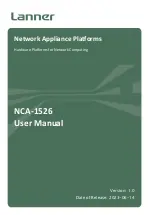
Best Data DSL542 ADSL Ethernet Router User’s Guide
38
Figure 28. NAT Rule
⎯
Add Page (filter Flavor)
Follow these instructions to add a filter rule (see steps 1-4 under "The napt rule" on page 33 for
specific instructions corresponding to steps 1 and 2 below):
1.
Display the NAT Rule – Add Page, select
FILTER
as the Rule Flavor, and enter a
Rule ID.
2.
Select the interface on which this rule will be effective.
3.
Select a protocol to which this rule applies, or choose
ALL
.
This selection specifies which type of Internet communication will be subject to this
translation rule. You can select ALL if the rule applies to all data. Or, select TCP, UDP,
ICMP, or a number from 1-255 that represents the IANA-specified protocol number.
4.
In the Local Address From and Local Address To fields, type the starting and ending
IP addresses that identify the range of private address you want to be translated. Or,
type the same address in both fields.
If you specify a range, each address will be translated in sequence to a corresponding
address in a range of global addresses (which you specify in step 5).
The address (or range of addresses) should correspond to a private addresses (or
addresses) already in use on your network. These may be assigned statically to your PCs
or assigned dynamically using DHCP.
5.
In the Global Address From and Global Address To fields, type the starting and
ending address that identify the range of public IP addresses to translate your private
addresses to. Or, type the same address in both fields (if you also specified a single
address in step 4).
6.
Specify a Destination Address or addresses, Destination Port (or ports), or both. You
can specify a single value by entering that value in both fields.
f
Specify a destination address (or range) if you want this rule to apply only to outbound
traffic to the address (or range).
If you enter only the network ID portion of the destination address, then the rule will
apply to outbound traffic to all computers on network.
f
Specify a destination ports (or range) if you want this rule to apply to any outbound
traffic to the types of servers identified by that port number.
Port number assignments are maintained in RFCs maintained by IANA. Common
port numbers include:
20, 21—FTP (file transfer protocol) server
25—SMTP (simple mail transfer protocol) server
80—HTTP (World Wide Web) server
















































